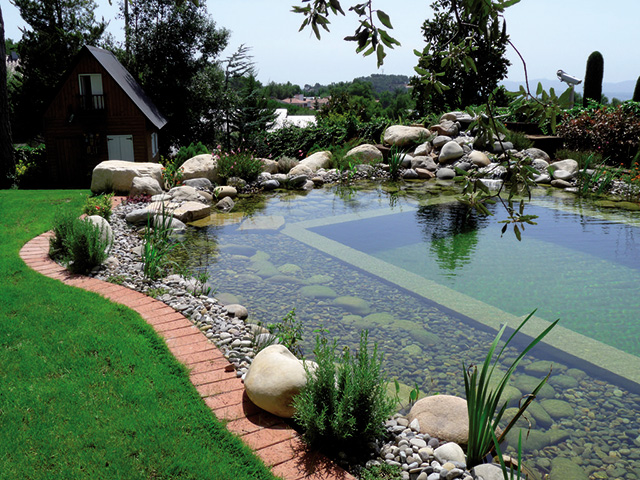 |
|
|
Where to Build a Pond
Where would you locate the pond and why does that matter?
Here are some good guidelines in a “quick read”.
The more sun your pond and fish get, the healthier they will be, but there are “gotchas”.
“Algae is medicine.” Algae (suspended and carpet) contributes to the equillibrium of the pond in ways which are amazing but also poorly understood.
Warm water carries less oxygen.
The further you are positioned above (or below) the earth’s equator, the more full sun your pond could stand.
I live in Georgia and my pond is positioned in 90% full sun. For me this is very feasible because I live in the foothills of the Appalachians and it’s relatively cool all summer. There is morning and evening shade but the pond is sun-drenched through the hottest hours of the day.
If you lived in Daytona Florida or Southern Arizona, I suspect that your fish pond would not fluorish in full sun without specialized engineering. We can discuss some of those issues shortly.
Where to Build a Pond
Advantages to placing the fish pond in full sun:
Direct sunlight is important to fish for proper vitamin and mineral absorption and metabolism. Sunlight also stimulates superior color in fish. You would notice this in the “reds” in particular.
Sunlight propagates the growth of algae in ponds. “Algae is medicine” and should be allowed to grow on the bottom and sides of your pond no matter how unsightly you’ve been conditioned to think it is. Algae reduces Nitrates which can compromise the health of your fish if allowed to accumulate to high levels for too long a time.
Suspended green algae which turns the pond into a kind of “pea soup” is also healthful to the fish, but “green water” creates difficulties in their observation. This is especially undesirable in the Springtime when disorders with the fish need to be observed and treated early. (See also discussion of dissolved oxygen)
Disadvantages to placing the fish pond in full sun:
Unless the pond is quite large and rather deep, full sunlight would be a problem from an overheating standpoint. For the most part, this is in consideration of the fact that warm water carries piteously little dissolved oxygen. Without aggressive aeration, a pond in the high eighties (DF) would be severely compromised as far as dissolved oxygen is concerned. Interestingly, Koi and goldfish will handle water temperatures in the nineties without physiological stress. I have a good friend who raised Koi in Vietnam and kept them in small facilities which were routinely in the nineties. Strict attention to redundant power and air supplies will ensure the fish are preserved. Pond water will collect heat from the air *and* from the direct radiant energy of the sun. By day’s end, a shallow or small pond can collect enough heat to cause problems.
Where to Build a Pond
Advantages to shading the pond:
The primary advantage to shading the pond is being able to avoid the over heating issues in the summer months. In the winter, if the pond is under deciduous trees which have shed their foliage, you will benefit from the supplemental heat of the winter sun. Another advantage derived from shading the pond, especially with a man made structure, is related to predators. The Great Blue Heron is a prodigious fish eater. Keeping the pond under cover can reduce the ponds visibility to this predator and perhaps help avoid his hungry visit.
Disadvantages to shading the pond:
The primary disadvantage of placing the pond in naturally occurring shade is that each Fall’s leaf and needle litter will cause MAJOR detriment to water quality if this debris is allowed to reside on the pond bottom. This is a more significant concern to persons considering a very large mud pond. Such ponds would be formidable to drain and clean and this would be a priority if the pond was accumulating large amounts of leaf and needle litter. DO NOT PERMIT YOUR FISH TO OVERWINTER with the Fall’s leaf litter on the bottom. I personally GUARANTEE you a major disease crisis in the Springtime if this is tolerated. By far the smartest hobbyists will leaf-net their ponds if leaves are going to be shed into the pond. If you place the pond under a man-made shelter, you will avoid the leaf problem in Fall, and the fish will be cooler all summer. Many persons with larger and more intricate pond designs will use a “shade cloth” which cuts a percentage of the sunlight coming to the pond. This allows beneficial algae to grow and fluorish without the obligatory increases in water temperature.
In consideration of all of the above, I think the most ideal ponds are placed in full sun and covered with a man made shelter which supports a shade cloth of a “percentage” suitable for your geography. This gives you full control over the summer exposures, but allows you to propagate a healthy green carpet of algae on the pond bottom. In the winter, at your choosing, you can uncover the shelter and allow more sun to reach the pond, and supplement the heat available to the fish.
If a man made shelter is undesirable, or out of the question, then the second best scenario would be a pond which catches most of the midday sun and has mature trees within forty feet of it to allow morning and evening shade. In these cases, the trees are far enough away to be of little concern as far as leaf litter. Since the “hypothetical pond” we’re talking about does get midday sun, you would make it correspondingly deeper and larger in warmer climates such as Florida or Arizona, in order to prevent wide temperature swings at night and overheating during the day.






